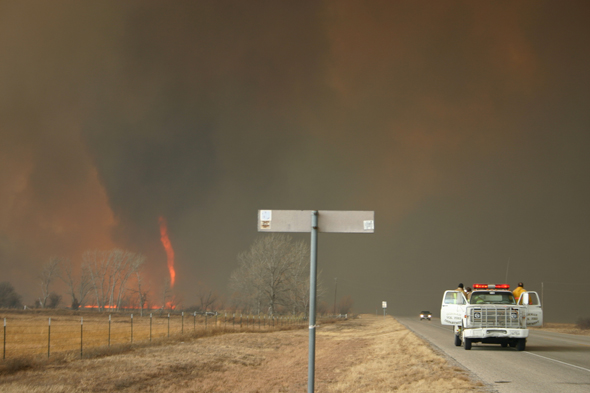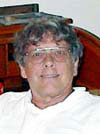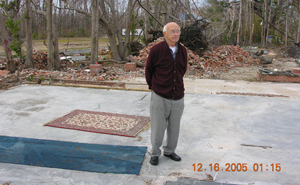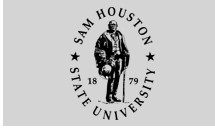 |
A 150-foot tall fire tornado approaches
Highway 6 on its way to the community of Kokomo in Eastland
County east of Abilene. The community was totally destroyed.
--Photo by Steven J. Hetrick |
Ruffin Researches Hurricane, Fire Devastation
 |
Paul Ruffin |
Paul Ruffin, regents distinguished professor of English at SHSU,
recently returned from trips to the Mississippi Gulf Coast, New
Orleans, and the site of large grass fires near Abilene.
"I wasn't driven by morbid curiosity, as many might think," Ruffin
says, "but rather by the desire to hear the stories of people
who lost essentially everything they owned and how they snapped
back. I wanted to observe the human spirit rally against
dreadful odds."
In mid-December he spent two days in Waveland and Pearlington,
Mississippi, judged to be ground zero when Katrina
came ashore for the last time. Then he drove down to New
Orleans' Lower Ninth Ward, which was so devastated by the levee
breaks.
"My intention initially was to find children on the Coast and
talk to them about what Christmas would be like for them, since
most of them had lost their homes and all their toys and were
living in tents and FEMA trailers and with kin. But, alas,
the children were gone from that blitzed landscape, where in
most blocks not a single building was left standing. A
thirty-two-foot storm surge does not show much mercy."
 |
Dr. David Skagerberg, retired orthopedic surgeon, stands
on all that was left of his home at Waveland, Miss. The rest
of his house is scattered behind him.
--Photo by Paul Ruffin |
After interviewing a handful of homeowners in Waveland, he finally
did find children at St. Clare's Catholic Church, right across
from the beach. The church and school had been completely
leveled by the hurricane, but the diocese had arranged to have
Quonset huts erected for administrative buildings, classrooms,
and eating and restroom facilities.
"It was quite a surprise to me to find that those kids, almost
all of whom were living in tents and FEMA trailers and who had
lost all their toys and many of their pets, were very enthusiastic
about Christmas. I interviewed grades 3-5, and they were
like kids anywhere. They didn't mind telling their stories,
about what had happened to their homes and pets, and they were
very eager to tell me what Christmas would be like for them. No
shock, no sadness: just the kind of joy you expect for children
with Christmas coming on."
Those were the only children he found in Waveland and Pearlington,
just to the west.
"I found not a single child in New Orleans' Lower Ninth Ward. There
was plenty of evidence that children had lived there--bikes and
stuffed animals and what was left of swing sets and trampolines-but
that was a childless land."
Ruffin did find a few homeowners to interview. "I ran
across a black lady named Jackie Gresham, who runs a tatoo parlor-calls
it Tat-2--and we had a nice conversation. Her place had
been flooded, and a city bulldozer had knocked a chunk out of
the wall of her building, but she was totally upbeat. Even
offered to give me a free tatoo." He declined.
"Most people think that the Lower Ninth suffered only flood
damage, but I'm here to tell you that the three to five blocks
just down from that levee looked like Waveland and Pearlington. Walls
of water nearly as high as the Mississippi Coast storm surge
slammed into that neighborhood and swept away houses and cars
and anything else in their path. I'm talking total devastation. Nothing
but slabs and steps left. Complete ruin. And all
this happened after Katrina had gone on off to the north and
people were beginning to return to their homes. I stood
atop the levee in the two places where breaches occurred, and
what I saw was unbelievable destruction-water so strong that
it snapped telephone poles."
Ruffin says that a thick, acidic sludge coated everything. "I
found a quarter that had been so etched by that water that I
could barely make out GW's face. In places the copper
core showed through."
He says that he does not know what will happen to the Lower
Ninth. "But I'll guarantee you that the few people I talked
to are going to put up one hell of a fight if the city does decide
to bulldoze that neighborhood and build up the level of the land
and place casinos and high-rises there, as has been rumored. You
know: turn the city into the Las Vegas of the South."
Shortly after Christmas the Cross Plains fire broke out and
destroyed a good part of that town, and five days later, on New
Year's Day, the great Eastland County fire burned over 35,000
acres and literally vaporized the little community of Kokomo.
"I just had to go up there and talk to those people," Ruffin
says. "I got to thinking about how the folks back on the
Mississippi Coast and in the Lower Ninth could find a few pieces
of their lives scattered among the ruins-wet and banged up, but
still salvageable. But when a wall of fire as tall as
Katrina's storm surge roars over your place, there can't be anything
left to salvage. Not a single photograph or
scrapbook. Everything is ashes."
He visited Cross Plains first and photographed slab after slab
where houses had recently stood. "It took everybody by
surprise. The fire broke out four miles outside town and,
driven by winds up to forty-five miles per hour, roared to the
northeast, simply demolishing everything in its path, but the
territory was rural, with few buildings. Everybody in
town thought they were safe. Just as the head of the fire
was northwest of town, an expected cold front came through and
turned the monster back toward Cross Plains. The timing
couldn't have been worse. Then the heavy winds of the
cold front were driving it just as fast as the southwest wind had been
driving it. Within less than eight minutes of its ignition,
the blaze reached town and roared through to the other side. Two
elderly ladies died in that one, and a big section of the town
was destroyed."
Ruffin spent two days covering the Eastland County fire, which
cut a swath nearly thirty miles long and destroyed fifty houses
and over a hundred outbuildings.
"In terms of size, this was the Cross Plains' fire's big brother," Ruffin
says. "Nobody died in it, but the loss of property was
unbelievable. Nothing was left standing in its path, except
for an occasional house where the owners or a volunteer fire
department truck managed to keep enough water on it to save it. Essentially
no outbuildings escaped burning. And nobody can begin
to calculate how much livestock and wildlife died."
Ruffin interviewed a number of landowners in the burned area,
including Larry Bryant, whose two sons lost houses on one side
of the highway and his daughter lost a house on the other. Bryant
managed to save his own home but lost every outbuilding. "Then
there was a guy named Bond, who lost all his outbuildings and
a good portion of his herd of Angus. The fire drove them
down and pinned them against a fence and caught most of
them on fire. He had to shoot several. I saw four
or five in a trench that he was getting ready to fill in. Their
hair was completely burned away. And there was a dazed
heifer walking around, her legs and underside and rear completely
seared. He's probably had to shoot her by now." The Bonds
saved their house by mounting sprinklers on the roof and at the
periphery of the yard and running them every day.
"And then there was Oren Webb, who saved a neighbor's home. When
his water was shut off--he was on a community water system--he
realized that his own place was doomed, so he raced up the hill
and saved an elderly lady's house with water hoses. Luckily
she had her own well. Now, that was heroic, in my eyes. And
the volunteer firemen, who risked their lives as they took stand
after stand against those walls of flames and fire tornadoes,
saving homes when they could, are all worthy of some sort of
national citation for their efforts."
Ruffin says that what he saw in those areas of devastation in
Mississippi, New Orleans, and Texas was the human spirit boldly
declaring itself in the face of adversity. "That's what
I was looking for, and that is what I found."
Out of his travels, Ruffin has generated five feature stories,
which have appeared in several newspapers, and he has at least
three more to write. He hopes to put together a book,
a pictorial essay on Waveland and the Lower Ninth Ward.
Since he has published two novels, two collections of short
stories, five collections of poetry, and a book of essays,
the question that had to be asked was whether he has become more
of a journalist than a literary writer now.
"Hardly," he says. "I have a book of short stories with
the University of South Carolina Press right now, and I have
two collections of essays under consideration. I'm working
on two novels as well. So, no, I still love my other writing,
but I have to tell you that I really do like doing feature stories
and columns."
During spring break Ruffin intends to head to the border and
conduct research on the Minutemen for a series of feature stories.
—END—
Text by Dan Sellers
SHSU Media Contact: Frank Krystyniak
Jan. 23, 2006
Please send comments, corrections, news tips to Today@Sam.edu.
|


